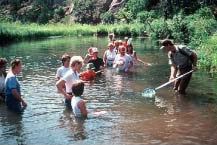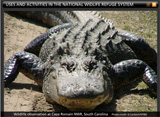What Uses And Activities Take Place On Refuges?
USES AND ACTIVITIES

People learning about stream ecology
Photo credit: E Smith/USFWS
The Refuge System not only protects fish, wildlife, and their habitats, it also provides great opportunities for appropriate public activities and uses. Refuges manage for wildlife-dependent recreation activities, protects historic sites, and supports scientific research.
As stated in the National Wildlife Refuge System Improvement Act of 1997, the six wildlife-dependent recreation activities are- hunting
- fishing
- wildlife observation
- photography
- environmental education
- interpretation
Read about the Act:
The National Wildlife Refuge System Improvement Act of 1997
POLICIES
To guide refuge managers in making decisions about refuge uses, federal policies were developed in 2006 for implementing the National Wildlife Refuge System Improvement Act of 1997. The goal of the policies is to better manage the Refuge System for wildlife and for people.
Interested in reading about these policies?
Federal Register published notices:
Refuge Uses Policy (83 KB PDF)
Wildlife-Dependent Recreational Uses Policy (91 KB PDF)
Three Policies Implementing the National Wildlife Refuge System Improvement Act of 1997 (4.3 MB PDF)
TAKE A TOUR
How does the public benefit from the Refuge System? View the slide show to find out about some of the uses and activities that take place on refuges.




